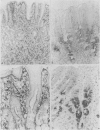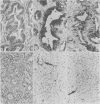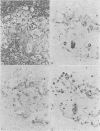Abstract
Using an immunoperoxidase technique the distribution of secretory component, IgA, and lysozyme has been investigated in normal, inflamed, dysplastic, and carcinomatous gastric mucosa. Apart from pyloric glands which contain lysozyme, normal gastric mucosa stains negatively for all three antigens. In gastric mucosa neck cells appear to adapt by synthesising secretory component and lysozyme and transporting IgA. Intense staining for the three antigens is seen in dysplastic gastric epithelium and in well-differentiated intestinal type carcinomas. With progressive de-differentiation the tumours lose the ability to synthesise secretory component and lysozyme. Carcinomas of the diffuse type stain positively for secretory component and lysozyme and individual cells appear to take up IgA even in the absence of surrounding IgA containing plasma cells. These functional properties are retained in lymph node metastases. It is suggested that secretory component synthesising malignant cells might take up circulating dimeric IgA and that this could be a reflection of an important physiological mechanism.
Full text
PDF


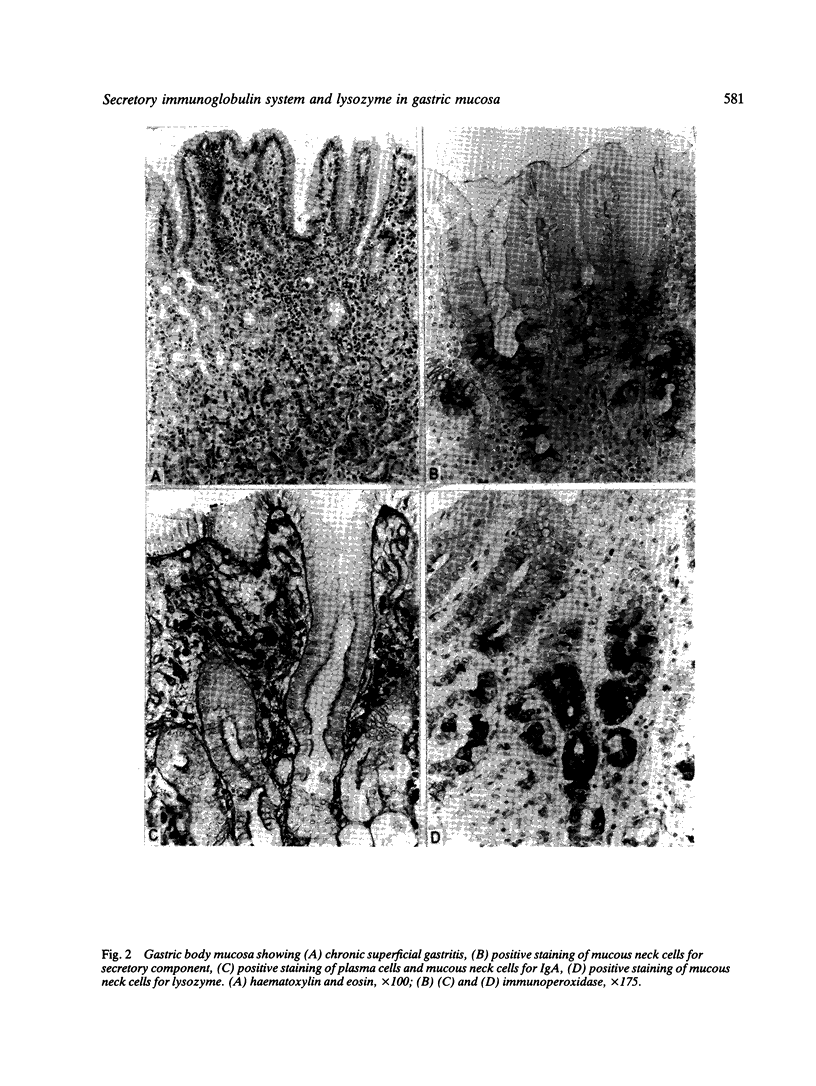

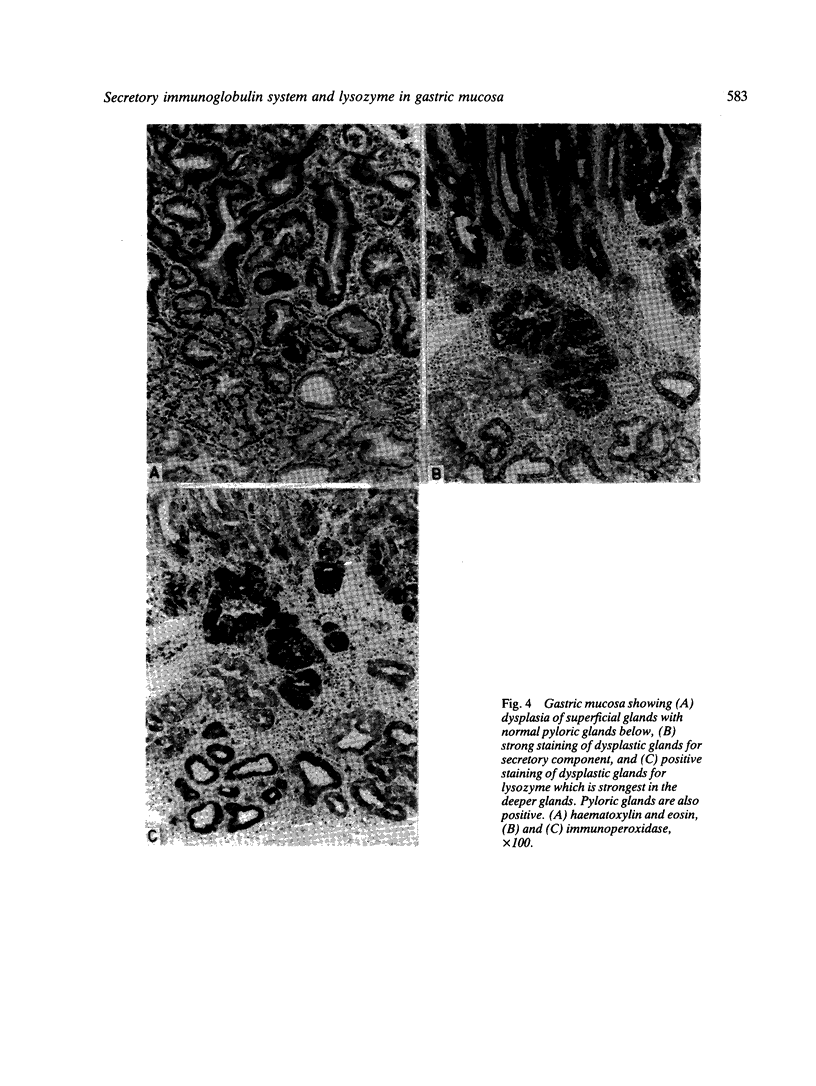





Images in this article
Selected References
These references are in PubMed. This may not be the complete list of references from this article.
- Brandtzaeg P. Transport models for secretory IgA and secretory IgM. Clin Exp Immunol. 1981 May;44(2):221–232. [PMC free article] [PubMed] [Google Scholar]
- Ejeckam G. C., Huang S. N., McCaughey W. T., Gold P. Immunohistopathologic study on carcinoembryonic antigen (CEA)-like material and immunoglobulin A in gastric malignancies. Cancer. 1979 Nov;44(5):1606–1614. doi: 10.1002/1097-0142(197911)44:5<1606::aid-cncr2820440511>3.0.co;2-r. [DOI] [PubMed] [Google Scholar]
- Isaacson P. Crypt cell carcinoma of the appendix (so-called adenocarcinoid tumor). Am J Surg Pathol. 1981 Apr;5(3):213–224. doi: 10.1097/00000478-198104000-00001. [DOI] [PubMed] [Google Scholar]
- Isaacson P. Immunoperoxidase study of the secretory immunoglobulin system in colonic neoplasia. J Clin Pathol. 1982 Jan;35(1):14–25. doi: 10.1136/jcp.35.1.14. [DOI] [PMC free article] [PubMed] [Google Scholar]
- Isaacson P., Wright D. H., Judd M. A., Mepham B. L. Primary gastrointestinal lymphomas: a classification of 66 cases. Cancer. 1979 May;43(5):1805–1809. doi: 10.1002/1097-0142(197905)43:5<1805::aid-cncr2820430534>3.0.co;2-6. [DOI] [PubMed] [Google Scholar]
- Klockars M., Reitamo S. Tissue distribution of lysozyme in man. J Histochem Cytochem. 1975 Dec;23(12):932–940. doi: 10.1177/23.12.1104708. [DOI] [PubMed] [Google Scholar]
- LAUREN P. THE TWO HISTOLOGICAL MAIN TYPES OF GASTRIC CARCINOMA: DIFFUSE AND SO-CALLED INTESTINAL-TYPE CARCINOMA. AN ATTEMPT AT A HISTO-CLINICAL CLASSIFICATION. Acta Pathol Microbiol Scand. 1965;64:31–49. doi: 10.1111/apm.1965.64.1.31. [DOI] [PubMed] [Google Scholar]
- Mason D. Y., Taylor C. R. The distribution of muramidase (lysozyme) in human tissues. J Clin Pathol. 1975 Feb;28(2):124–132. doi: 10.1136/jcp.28.2.124. [DOI] [PMC free article] [PubMed] [Google Scholar]
- Mepham B. L., Frater W., Mitchell B. S. The use of proteolytic enzymes to improve immunoglobulin staining by the PAP technique. Histochem J. 1979 May;11(3):345–357. doi: 10.1007/BF01005033. [DOI] [PubMed] [Google Scholar]
- Montero C., Erlandsen S. L. Immunocytochemical and histochemical studies on intestinal epithelial cells producing both lysozyme and mucosubstance. Anat Rec. 1978 Jan;190(1):127–141. doi: 10.1002/ar.1091900111. [DOI] [PubMed] [Google Scholar]
- Morson B. C., Sobin L. H., Grundmann E., Johansen A., Nagayo T., Serck-Hanssen A. Precancerous conditions and epithelial dysplasia in the stomach. J Clin Pathol. 1980 Aug;33(8):711–721. doi: 10.1136/jcp.33.8.711. [DOI] [PMC free article] [PubMed] [Google Scholar]
- Nagura H., Smith P. D., Nakane P. K., Brown W. R. IGA in human bile and liver. J Immunol. 1981 Feb;126(2):587–595. [PubMed] [Google Scholar]
- Pinkus G. S., Said J. W. Profile of intracytoplasmic lysozyme in normal tissues, myeloproliferative disorders, hairy cell leukemia, and other pathologic processes. An immunoperoxidase study of paraffin sections and smears. Am J Pathol. 1977 Nov;89(2):351–366. [PMC free article] [PubMed] [Google Scholar]
- Poger M. E., Hirsch B. R., Lamm M. E. Synthesis of secretory component by colonic neoplasms. Am J Pathol. 1976 Feb;82(2):327–338. [PMC free article] [PubMed] [Google Scholar]
- Rognum T. O., Brandtzaeg P., Orjasaeter H., Fausa O. Immunohistochemistry of epithelial cell markers in normal and pathological colon mucosa. Comparison of results based on routine formalin- and cold ethanol-fixation methods. Histochemistry. 1980;67(1):7–21. doi: 10.1007/BF00490083. [DOI] [PubMed] [Google Scholar]
- Weisz-Carrington P., Poger M. E., Lamm M. E. Secretory immunoglobulins in colonic neoplasms. Am J Pathol. 1976 Nov;85(2):303–316. [PMC free article] [PubMed] [Google Scholar]




